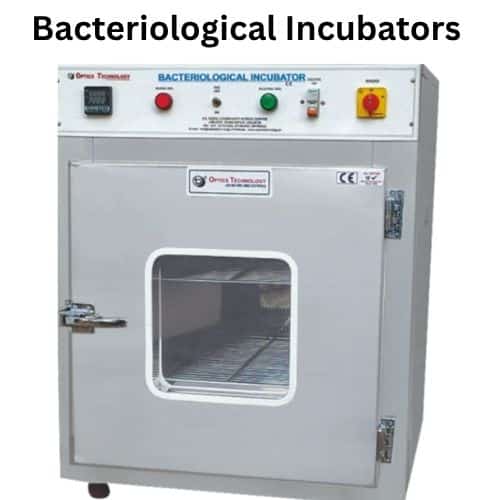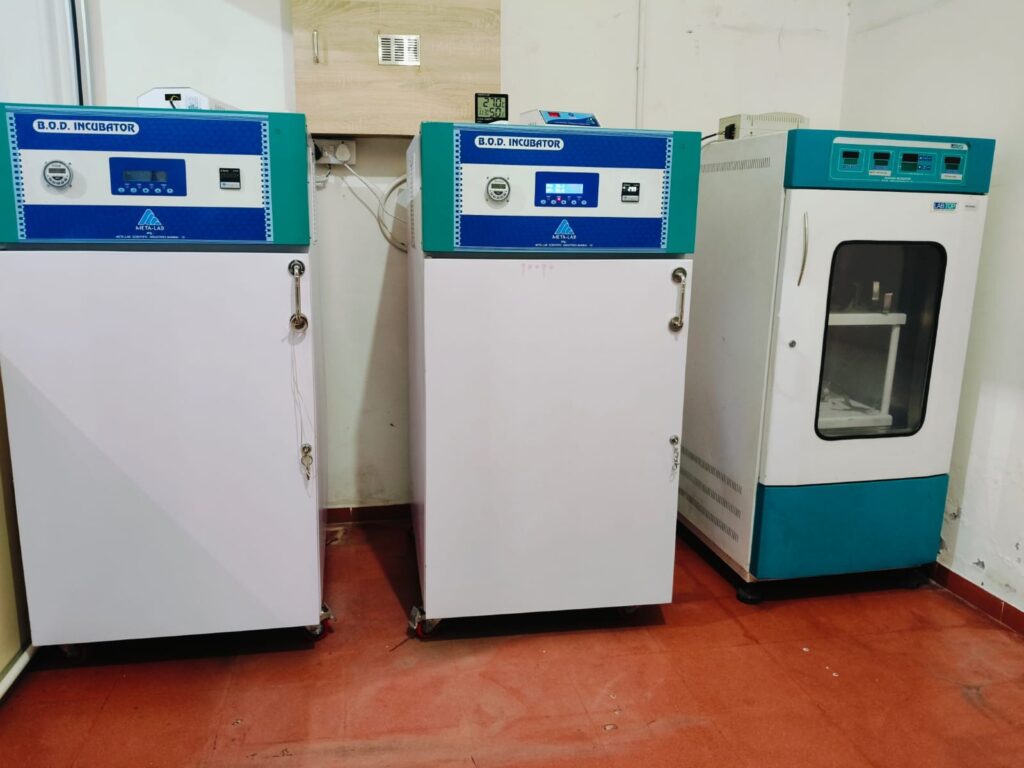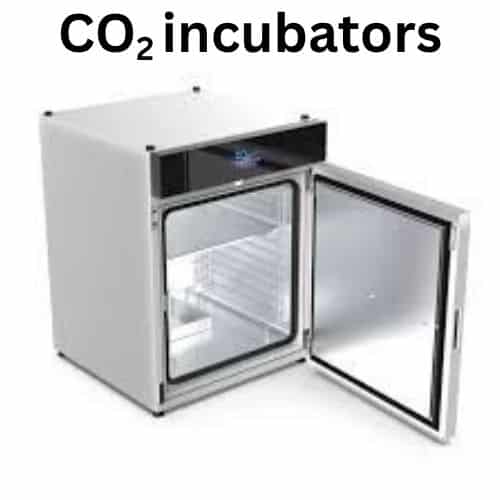Introduction to Incubator in Microbiology
A laboratory incubator is a vital instrument used to create controlled environmental conditions—such as temperature, humidity, and CO₂ concentration—to support the growth of microorganisms, cell cultures, or tissue samples. These devices play an essential role in fields like microbiology, biotechnology, pharmaceutical research, and clinical diagnostics, providing an optimal environment for biological development.
Typically operating at 35–37°C, which mimics the human body temperature, incubators are widely used for growing human pathogens and maintaining microbial cultures.
Working Principle of Incubator
The working principle of an incubator is based on the thermoelectric effect—the transformation of thermal energy into electrical energy. A thermostat regulates the internal temperature by generating a thermal gradient, which in turn maintains the desired conditions for microbial or cell culture growth.
Key Components in Temperature Control:
- Controller: Maintains the set temperature.
- Contractor: Regulates power supply to heating elements.
- Heating Bulbs & Fans: Distribute heat uniformly.
- Sensor: Monitors real-time temperature.
- Thermometer: Displays temperature inside the incubator.
Different organisms require different incubation temperatures:
- Mesophilic bacteria: 37°C
- Yeast and molds: 25–28°C
Types of Laboratory Incubators
The most prevalent kinds of incubators include:
- Bacteriological Incubators
- BOD Incubators
- CO2 Incubators
1. Bacteriological Incubator
Microbiology labs commonly use these incubators for bacterial culture growth. They heat-regulate (no cooling mechanism) and operate between 35–37°C. They include programmable settings, a thermometer, and insulation to maintain internal conditions. The thermostat regulates the temperature, allowing for a consistent temperature set to the need. A thermometer attached to incubators displays the correct temperature.

2. BOD Incubator (Biological Oxygen Demand Incubator)
Also known as Low Temperature Incubators, these are used for fungal cultures, especially molds and yeasts, which require lower incubation temperatures (20–25°C). BOD incubators are also essential for wastewater testing to assess biological oxygen demand. Since a low temperature of about 20–25°C is necessary for biological oxygen demand testing, these incubators are known as BOD (biological oxygen demand) incubators. Therefore, don’t mix up the word because the function of BOD incubators is the same as that of bacteriological incubators.

3. CO₂ Incubator
CO₂ incubators are specially designed for tissue culture and cell line experiments, where precise control of CO₂ levels, humidity, and temperature is critical. The primary use for CO2 incubators is this technique of growing live creatures in vitro.

Parts of an Incubator
- Thermometer: measures and shows the incubators inside temperature to make sure it stays at the intended set point.
- Two-wall insulated chamber – Reduces heat loss and offers effective insulation to help keep the inside temperature steady.
- Air circulating fan: keeps a consistent temperature throughout the space by distributing warm air evenly.
- Perforated tray – Offers a surface for culture plates or tubes, with holes allowing for appropriate air flow.
- Temperature regulator – Based on the set value, regulates the heating element to maintain the ideal interior temperature.
- Power indicator – A light that indicates if the incubator is turned on.
- Heating switch – Regulates interior warmth by turning the heating system on or off.
- Main switch: The main control for turning the incubator on or off.
- Asbestos door gasket – Guarantees a tight seal on the outside door to keep heat from escaping and maintain consistent inside temperatures.
Incubator Handling Procedures
- Prepare and inoculate samples (e.g., Petri dishes, test tubes).
- Power on the incubator and adjust temperature/CO₂ as needed.
- Insert samples and close the door securely.
- Allow for appropriate incubation duration.
- Remove samples and turn off the incubator.
Applications of Laboratory Incubators
- Microorganism cultivation: Incubators create the best conditions for cultivating a variety of microbial and cell cultures in the laboratory.
- Culture Maintenance: These devices keep creatures at specified temperatures for long periods while preserving their viability for future use.
- Growth enhancement: Some specialised incubators promote the growth of slow-growing organisms, which are commonly found in natural settings for extended growth periods.
- Biochemical Testing: Used in BOD and enzyme activity studies.
- Zoological Studies: Hatching of insect/bird eggs under controlled environments.
- Food Testing: Identify pathogens in food safety labs.
- Pharmaceutical research: These devices facilitate a variety of pharmaceutical investigations by providing predetermined temperature and humidity conditions.
- Environmental Monitoring: Assess microbial contamination in air, water, or soil.
- Crystal Growth: Used for growing protein or salt crystals.
Uses of Incubator in Laboratory
- In microbiology labs, an incubator is used to cultivate bacteria, fungi, and other microorganisms.
- Similarly, it aids in the propagation of viruses in cell cultures.
- Similarly, in zoology laboratories, an incubator creates the environment for hatching insect, bird, and other oviparous organism eggs.
- It also assists in storing biological samples before analysis in medical laboratories.
Advantages of Laboratory Incubators
- Energy Efficient – Low power consumption.
- Customizable – Adjustable parameters for various applications.
- Stable Environment – Reliable temperature and humidity control.
- Versatile – Suitable for microbiology, biotechnology, and pharmaceutical use.
Disadvantages and Risks
- Risk of Contamination – Poor sterilization practices can promote microbial contamination.
- Humidity Sensitivity – Moist environments may encourage growth of unwanted organisms.
- Cross-contamination – Inadequate isolation can affect multiple cultures.
Precautions When Using an Incubator
- Avoid frequent door opening.
- Keep temperature stable at all times.
- Clean and disinfect regularly.
- Use cotton plugs or moisture chambers for extended incubations.
- Label all cultures clearly to avoid mix-ups.
Conclusion
The incubator is a cornerstone of modern microbiological and biomedical research. By maintaining optimal environmental conditions, it supports the accurate cultivation and analysis of microorganisms, cell cultures, and biological samples. Proper use, regular cleaning, and contamination control are essential to ensure reliable and reproducible results.
Also Read
- Bioremediation: Definition, Types, Process and Application
- Milk: Composition, Processing, Pasteurization, Pathogens and Spoilage
- Influence of Environmental Factors on Microbial Growth
- Biosafety Cabinet: Introduction, Development and Safety guidance
- Methods for Laboratory diagnosis of viral infections
- Food Intoxication caused by Staphylococcus aureus
Play Microbiology Quiz→ Click Here

